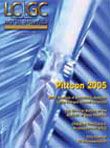Profiles in Practice Series: Metabolism Identification and Structural Characterization in Drug Discovery
LCGC North America
In this initial installment of "MS - The Practical Art," a new series of columns is introduced that investigates various aspects of mass spectrometry (MS) from the perspective of some leading practitioners. Here, featured scientists Kathleen Cox and Timothy Baker discuss several MS technologies and strategies currently being applied to characterize drug candidates in early stage development.
Throughout 2005 in this column, we will investigate various aspects of mass spectrometry (MS), viewed from the perspective of some leading practitioners. I wish to acknowledge at the outset their gracious cooperation in this project. Their willingness to share knowledge gained from years of highly successful efforts so that I might distill it into a few thousand words to benefit the rest of us speaks well of their dedication. In this month's installment, I specifically want to thank Kathleen Cox and Timothy Baker for their time and effort in discussing metabolism identification and structural characterization.

Michael P. Balogh
A number of mechanisms exist to eliminate drugs and other foreign substances from the body. Enzymatic alterations provide the most common ways of producing a more polar compound and therefore improving clearance of a drug. But alteration has some important physiological effects, including prolonging or (more commonly) halting a desired effect. So for every pharmaceutical endeavor, early metabolism identification and structural characterization is an important aspect of drug discovery and development.
Traditionally, metabolite characterization studies were conducted on a drug candidate only after the compound had progressed significantly into the development phase. Today, pharmaceutical researchers face increasing demands for information about potential drug candidates early in discovery programs. This not only saves costly resources later but also provides feedback to chemists to focus their synthetic efforts. Discovery scientists are challenged to formulate a methodology for transforming characterization studies, traditionally time- and labor-intensive, so that they apply to the fast-paced, dynamic discovery environment. Thus, the strategy adopted in discovery programs is to use state-of-the-art analytical techniques, not to provide comprehensive identification of every metabolite, but to provide information critical to the discovery team. Depending upon the program, this can be achieved by using a relatively rapid assessment of many compounds incubated in in vitro systems or fewer compounds from in vivo studies.

This Months Featured Scientists
Identification takes place after introducing a new chemical entity (NCE) into a test animal or following incubation in hepatocyte or subcellular microsomal fractions. In either case, the intention is to characterize specific locations on the NCE structure that become altered in the metabolic process. Knowledge of possible toxicity or insufficient metabolic stability is important information needed to modify a succeeding generation of molecules on the path to drug candidates with improved pharmacokinetic parameters.
Challenges in Metabolite Characterization Studies
The skills required to obtain quality data from properly applied instrumentation, skills that provide a definitive response for projects, are important to all companies. Yet within individual organizations, what we might term "cultural differences" impel decision makers and their staffs to customize methods. For instance, where a company goal is to provide structure-activity relationships for a series of chemical analogs, it makes sense to exploit the relatively high-throughput option of using in vitro samples. This reflects needs that are subtly different from those of a company providing a more comprehensive evaluation of a drug in a whole body system.
Given equal effort, working from in vitro samples yields more specific expected metabolites and metabolic trends, and therefore, often is less problematic than characterizing metabolic pathways from in vivo bile and urine samples. In the absence of radioactive tags and other indicators (such as specific signatures from attached halogens), the practitioner working with in vivo samples is faced with a more complex situation. There might be some expectation of the metabolites formed in vivo, because Phase I pathways are well-characterized. In some cases, in vitro results can even act as indicators of major metabolic routes from which to make assumptions about in vivo work.
Kathleen Cox, associate director, exploratory drug metabolism at Schering Plough Research Institute (Kenilworth, New Jersey), says the number of samples processed in an average week is relatively low, fewer than 100, but the work is labor intensive nonetheless. The samples' origins in bile and urine bespeak the need to capture all nuances of metabolic creation from the administered dose. Overdosing in early studies to enhance sensitivity, for example, can present misleading information by saturating pathways when lower doses in humans are required. Ultimately, a streamlined process is desirable to avoid inconsistencies between these early steps and methods used in later development, such as plasma studies.
While in vitro samples still are employed in Cox's work, an in vivo approach is used to answer specific questions such as characterizing the primary metabolic pathway and whether or not specific or toxic metabolites are formed. To minimize the risk of removing low-level entities, while being able to detect very low quantities of metabolites present in the matrix, no sample preparation is performed at this early stage. More important than high-throughput considerations is detecting critical metabolites and differentiating them from the complex physiological matrix through interpretation using software and methodologies to enhance the effort.
In a recent publication, Cox and her colleagues detail the tiered approach to metabolic characterization that they developed (1). A "triage" designed to yield early insight regarding a structure's potential metabolic sites is performed via MS-MS in constant neutral loss mode. At this point, little about the expected metabolites is known, so the loss of a well-characterized moiety from the parent compound is a critical indicator. Considering the challenges of working with a complex ("dirty") matrix, this quick assessment yields a high number of good-quality results, often indicating structure, especially when followed by a second-tier assessment on a different instrument. That the structure revealed is unrefined is of less consequence. An early indication of potentially toxic metabolic conjugates such as glutathione, acyl glucuronide, or sulfate metabolites and an indication of metabolically active locations - "left versus right" based upon symmetry of the structure in question - suffices. Later studies with nuclear magnetic resonance and more precise quantitation and characterization follow.
Consistent with pharmaceutical industry practice, the mass spectrometers often used in the early assessments are triple quadrupoles. The ability to perform various MS-MS scan functions (that is, precursor, constant neutral loss, and product ion scans) provides maximum flexibility. Having more than one manufacturer's design available also is helpful because fragmentation differences can be seen; one instrument with any given structure can yield more useful information than another.
Accurate Mass and Assessing Mass Defects
More detailed assessments typically rely on the hybrid quadrupole matched to a time-of-flight (QTOF) design and to a lesser extent, on an ion trap. Although the ion trap's fragmentation capabilities are limited, it does offer the potential for multiple fragmentation experiments (MS
n
), and successive losses can yield structural clues. The QTOF design provides high mass-accuracy response - the ability to measure within a few parts per million of the true, calculated, monoisotopic value. Note that for a given hypothetical mass, for example 400.0000, an instrument capable of measuring that known mass with an error of 0.0020 (2 mDa or 2 milli-mass units) is said to be accurate to 5 ppm (error in measurement/true mass value, or 0.002/400 Ã 10
6
) (2). Such accuracy enables the determination of empirical formulas based upon mass defect (3). Together with up to a 10-fold increase in resolution compared to the quadrupole, this accuracy permits the QTOF system to differentiate an unknown based on mass defect (4). Thus, we can discern the difference between an aldehyde and a sulfide with, for instance, an increase in mass accuracy above the quadrupole limits of only 30 ppm, whereas the two differ in monoisotopic mass by 0.035 Da.
More precise differentiation is more demanding. Consider the metabolic process of methylation (addition of CH2), which increases mass over the precursor (the instrument's response for the drug alone) by +14.0157. Consider also a two-stage biotransformation involving hydroxylation (addition of oxygen) followed by oxidation at a double bond (loss of H2), which increases mass by +13.9792. Though the two mass measurements +14.0157 and +13.9792 obviously differ by 0.0365 Da, the shortcomings of quadrupole resolution will cause each to appear to differ by +14, whereas the QTOF system clearly distinguishes the difference in the same analysis.
Timothy Baker, principal scientist with Procter & Gamble Pharmaceuticals, Inc. (Mason, Ohio) says his laboratory's strategy, where in vitro assessments play a large role, also requires a variety of tools be at his disposal. The group employs ion traps but favors fraction collection to supply nuclear magnetic resonance samples when a greater degree of characterization is required. The traditional role of the triple quadrupole is giving way to the QTOF mass spectrometer. As an example, he states that a low-level signal producing "fifty counts" on a triple quadrupole in MS or MS-MS mode "inspires no confidence. However, an accurate mass measurement of similar intensity on a QTOF [system] provides the empirical formula of the ion, a strong indicator it is drug-related." Baker's group performs no constant neutral loss or parent scanning. Instead, it emphasizes comparing control ("zero hour" or "predose") samples to the study and searching for expected outcomes using high-resolution exact mass chromatograms. Of course, this approach has limits, too. The reference samples are of physiological origin, so they can differ significantly depending upon what the subject ingested and when the sample was taken.
Baker's experience during the past 15 years has led him to create a narrow-bore analytical system that he applies to discovery and development studies, including those for plasma (5). It involves a liquid chromatography (LC) preparative step using 15 μL/min flow rates to deposit the sample onto a 500-μm i.d. trapping column followed by backflushing onto an analytical column of the same dimension. This lets the practitioners concentrate and clean low-level samples, reducing the sensitivity burden on the mass spectrometer, while maintaining "method parallelism" with separations that will be done later for preclinical and mass balance studies.
Regardless of the approach, the reliance always is on dependable, rugged, well-integrated LC systems, mass spectrometers, and software applications.
New Technologies and Commonly Employed Techniques
As I mentioned earlier, improved instruments make practices such as observing mass defects possible where, for a given structure, losses from the precursor can be differentiated by as little as a few parts per million. For instance, even a single pass can indicate an endogenous entity from a metabolite in a complex mixture, essentially eliminating the "noise" associated with samples that are not differentiated as well. Background subtraction software is among the most useful tools found in practice over the years. Component detection algorithm software, an often-cited example, has been developed by several companies based on original work at Eastman (Kingsport, Tennessee) (6). Isotope tracking also proves useful and is used with halogenated compounds, whose characteristic spectra facilitate tracking locations on the molecule.
Exact mass determinations are becoming more common. Baker's typical practice of constraining the possible outcomes of formula composition to those < 5 ppm using "tight" windows (0.02-0.05 Da) often results in a single empirical formula. Soon it will be easier to run a "dirty" sample without risking removal of minute metabolites. Using exact mass in postprocessing to successively narrow the result from the parent or precursor drug down to metabolites differentiated by only 2 mDa, without altering the raw data originally acquired, will prove particularly useful. Based upon limited knowledge, such as the starting structure and an exact mass acquisition, the postprocessing software could then return only a hit or two out of possibly hundreds of Phase I and Phase II legitimate possibilities. A quadrupole limited to 40-mDa accuracy might do no better than 50 or so possible candidates (7).
Other tools such as in silico or metabolite prediction software are employed less widely until the consensus indicates their utility. Similarly, fragmentation software, even when employing accurate mass results, still requires an expert assessment. Baker's caveat is well-established from practice: "While software is clearly an advantageous tool to reduce the number of possibilities, software by itself does not produce an infallible answer."
New technologies attract the perennial attention of spectrometrists, who closely monitor developments such as photoionization and nanospray devices. Project schedules often leave little time for experimentation and opportunities to codevelop novel technologies. Yet the new technologies will solve many of today's problems once the practical hurdles are surmounted. Photoionization, for instance, is of interest. Although nonpolar NCEs appear infrequently in pharmaceutical practice, the need to ionize compounds not amenable to electrospray does exist. Today, the need usually is met by resorting to an "off-line" method such as electron ionization. Atmospheric-pressure chemical ionization (APCI) often is used for less polar or neutral entities but does not extend as far into that range as is promised by photoionization. APCI also can introduce artifacts or destroy thermally labile moieties, as the well-documented heat-related problem of N-oxide analysis proves (8).
In most discovery strategies, because no standards are immediately available for the metabolites, initial quantitation by MS is ineffective. Ionization efficiency of the NCE can be quite different from that of its metabolites. Where those involved with in vitro work often can employ UV detection, the complex matrix-induced interference of bile and urine samples makes UV impractical. Alternative technologies are being sought. Nitrogen-based detectors have been touted but have not fared so well because the immediate environment contains numerous nitrogen-based potential artifacts.
Any technology employable at reasonable cost that provides enhanced selectivity and definition is decidedly beneficial, especially in complex sample matrixes. According to both Cox and Baker, recently introduced columns with <2-μm particle diameters are garnering interest, particularly those used for ultrahigh pressure liquid chromatography (UPLC) systems such as Acquity UPLC (Waters, Milford, Massachusetts). In Cox's estimation, "The timing for the introduction [to the market] of this technology is perfect" because mass spectrometers now are available with greatly enhanced acquisition speeds that allow them to acquire useful information from peaks that are only 1-2 s wide (9).
Still, more capabilities are needed, especially considering the imperative to obtain more information earlier in the drug discovery process. Cox's views reflect the needs: "Strategic decisions are made to answer critical questions, although the technology is available to do much more. There are tradeoffs involved in any strategy. In vitro methods provide resource-efficient, high-throughput options, making the evaluation of large numbers of compounds feasible. However, the data is not guaranteed to be comprehensive of all metabolic pathways possible. Methodologies involving in vivo samples, while providing a comprehensive metabolite profile, are resource-intensive in terms of generation of samples (animals and dosing are required) and require a great deal of time and interpretive skills, both by the analyst and the software, to filter out relevant metabolism information from an often prohibitively complex matrix."
Having invested so long and well in their profession, Cox and Baker share a similar view. Cox states, "The field of metabolite characterization in drug discovery is an exciting and dynamic one, full of promise and opportunity for the future to provide a comprehensive, critical evaluation of NCEs, which will inevitably focus and direct discovery programs and lead to safe and effective marketed drugs."
References
(1) K.A. Cox, D. Grotz, D. Rindgen, and D.J. Weston,
Advances in Mass Spectrometry vol. 16
, A.E. Ashcroft, G. Brenton, and J.J. Monaghan, Eds. (Elsevier, New York, 2004), pp. 201-214.
(2) M.P. Balogh, LCGC 22(2), 118-130 (2004).
(3) M. McCullagh, J. Castro-Perez, A. Baker, and J.A. Granger, ISSX Drug Metabolism, Vancouver, BC, Canada, Aug 29-Sept. 1, 2004.
(4) M.P. Balogh, LCGC 22 (2), 118-130 (2004).
(5) D.J. Foltz, J.C. Perez, P. Riley, J.R. Entwistle, and T.R. Baker, J. Chromatogr., B, in press.
(6) W. Windig, J.M. Phalp, and A.W. Payne, Anal. Chem. 68, 3602-3606 (1996).
(7) Metabolynx development software, Waters Corporation, Milford, Massachusetts (unpublished data).
(8) W. Tong, S.K. Chowdhury, J.-C. Chen, R. Zhong, K.B. Alton, and J.E. Patrick, Rapid Commun. Mass Spectrom. 15(22), 2085-2090 (2001).
(9) M.P. Balogh, LCGC 22(11), 1082-1090, (2004).
Michael P. Balogh "MS - The Practical Art" Editor Michael P. Balogh is principal scientist, LCâMS technology development, at Waters Corp. (Milford, Massachusetts); an adjunct professor and visiting scientist at Roger Williams University (Bristol, Rhode Island); and a member of LCGC's editorial advisory board. Direct correspondence about this column to "MS - The Practical Art,"LCGC, Woodbridge Corporate Plaza, 485 Route 1 South, Building F, First Floor, Iselin, NJ 08830, e-mail lcgcedit@lcgcmag.com.

New Study Reviews Chromatography Methods for Flavonoid Analysis
April 21st 2025Flavonoids are widely used metabolites that carry out various functions in different industries, such as food and cosmetics. Detecting, separating, and quantifying them in fruit species can be a complicated process.

.png&w=3840&q=75)

.png&w=3840&q=75)



.png&w=3840&q=75)



.png&w=3840&q=75)












